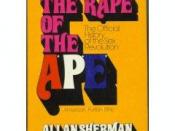Rape in general is defined as ÃÂinstances in which the victim is physically forced, verbally threatened, or under the influence of drugs that would make her or him incapable of making a decision or resisting the attack,ÃÂ (Abramovitz 2001). Date rape refers to any non-consensual sexual activity involving two people who know one another- ÃÂacquaintance rape.ÃÂ It involves one person (the rapist) who forces another person (the victim) into sexual interactions. Date rape does not always include drugs, though many times a sedative is utilized to knock the victim unconscious prior to the actual act. While most rape cases involve a male attacker and a female victim, the inverse can (and does) occur with some semblance of frequency. It is incredibly important to not only keep an attentive mind, but to take as many preventative measures as possible to further eliminate the chance of date rape.
According to Schwartz et al, drug-facilitated date rape accounts for roughly twenty-five percent of the nearly 1,400 rapes reported to the Canadian Sexual Assault center every year (2000: 80).
Date rape drugs are also referred to as ÃÂclub drugsÃÂ due to the fact that they are most commonly used at dance clubs and/or raves. The three most commonly utilized date rape drugs areflunitrazepan (Rohypnol), gamma hydroxybutyrate (GHB), and ketamine hydrochloride. In the United States, both Rohypnol and GHB are illegal, and ketamine is very tightly regulated.
Because of this, many of the drugs are imported from Mexico or Latin America, or secretly concocted in the United States with incredibly toxic and lethal ingredients. These high-risk components put victims at risk of poisoning or overdosing, resulting in death. Additionally, date rape drugs have potentially long lasting effects on the brain and are highly addictive. They can lead to the impairment of motor skills...


